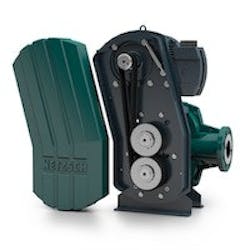Rotary Lobe Pump Offers Durability, Ease of Maintenance
Netzsch's Tornado T2, a technologically advanced rotary lobe pump, features lobes running inside a metal housing with a replaceable elastomer liner. This design breakthrough does not require O-rings or gaskets yet delivers durable, robust construction along with simplicity and ease of maintenance. A single, synchronous toothed timing belt, technology common to the automotive industry, eliminates the maintenance-intensive and costly gearbox.
A pulsation reduction system of channels molded into the rubber walls of the pumping element, releases lobe energy and dampens pulsation. The unique housing design permits full flange-to-flange access when servicing the pump and offers more room to get into pump internals without having to disassemble piping.
Full “service-in-place” engineering provides easy access to the mechanical seals, rotors, liners, as well as for timing the lobes. The single timing belt drive eliminates the need for a second reduction component to the pump. There is no oil to replace or maintain and there are no timing gears to fail. In fact, Netzsch does not consider the timing belt to be a wear-part, having undergone intensive testing of 10 million start-stop cycles.
Contact Us
NETZSCH Pump North America LLC
Exton, PA
610.363.8010
www.netzschusa.com
[email protected]
